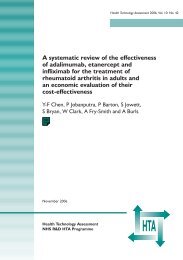Measuring Athlete Imagery Ability: The Sport ... - ResearchGate
Measuring Athlete Imagery Ability: The Sport ... - ResearchGate
Measuring Athlete Imagery Ability: The Sport ... - ResearchGate
Create successful ePaper yourself
Turn your PDF publications into a flip-book with our unique Google optimized e-Paper software.
426 Williams and Cumming<br />
Confirmatory Factor Analysis (CFA)<br />
Data were analyzed via structural equation modeling with maximum likelihood<br />
estimations using the computer package AMOS 16.0 (Arbuckle, 1999). 1 Based<br />
on the significant correlations between subscales in Study 1, a model in which<br />
subscales were allowed to correlate (i.e., correlated traits model) was created.<br />
<strong>The</strong> model’s overall goodness of fit was tested using the chi-squared likelihood<br />
ratio statistic (χ 2 ), with a larger value indicating a poorer fit (Jöreskog &<br />
Sörbom, 1993).<br />
Although a nonsignificant χ 2 value represents a good model fit, this is very<br />
rarely obtained in practice (MacCallum, 2003). Consequently, based on Hu<br />
and Bentler’s (1999) recommendations, two types of additional fit indices are<br />
reported, the standardized root mean square residual (SRMR; Bentler, 1995) and<br />
a supplementary incremental fit index (e.g., Tucker–Lewis index, comparative fit<br />
index, or root mean square error of approximation). <strong>The</strong> SRMR, used to calculate<br />
the average difference between the sample variances and covariances and the<br />
estimated population variances and covariance, is a measure of absolute fit index<br />
(Tabachnick & Fidell, 2007). An adequate fit is indicated by a value close to<br />
0.08 (Hu & Bentler, 1999). <strong>The</strong> Comparative Fit Index (CFI; Bentler, 1990) and<br />
the Tucker–Lewis index (TLI; Bollen, 1989) compare the estimated model to an<br />
independence model using different approaches (Jöreskog & Sörbom, 1993). For<br />
both fit indices, a cut-off value of close to 0.95 has been suggested to indicate an<br />
adequate fit (Hu & Bentler, 1999). Finally, an assessment of how well the model<br />
approximates the data is calculated by the root mean square error of approximation<br />
(RMSEA; Steiger, 1990). <strong>The</strong> RMSEA determines the model’s estimated<br />
lack of fit to a population covariance matrix expressed as the discrepancy per<br />
degree of freedom (Browne & Cudeck, 1993). A cut-off value close to 0.06 indicates<br />
an adequate fit (Hu & Bentler, 1999). Finally, standardized factor loadings,<br />
standardized residuals, and modification indices were examined to investigate<br />
any model misspecification. It is important to note there is some debate in the<br />
literature with regards to how appropriate the values indicative of adequate model<br />
fit are (see Markland, 2007; Marsh, Hau, & Wen, 2004). For this reason, caution<br />
is advised when interpreting results. Despite this issue, these criteria are still the<br />
most commonly reported as indications of an adequate model fit.<br />
Inspection of Mardia’s coefficient (Mardia, 1970) revealed data did not<br />
display multivariate normality (Mardia’s multivariate kurtosis = 19.37; normalized<br />
estimate = 9.74). Consequently, the bootstrapping technique was employed.<br />
This method enables the creation of multiple subsamples from the original data<br />
and then parameter distributions examined relative to each of these samples<br />
(Byrne, 2010).<br />
<strong>The</strong> four-factor model identified in Study 1 demonstrated an adequate fit to<br />
the data in Study 2, χ 2 (48) = 96.19, p < .05, CFI = .96, TLI = .95, SRMR = .05,<br />
RMSEA = .05 (90% CI = 0.04–0.07). Inspection of the standardized factor loadings<br />
(ranging from 0.58 to 0.86), modification indices, and standardized residuals<br />
revealed all values were within acceptable limits and no offending estimates<br />
existed (Hair et al., 1998). Consequently, each item meaningfully contributed to<br />
its intended subscale.
















